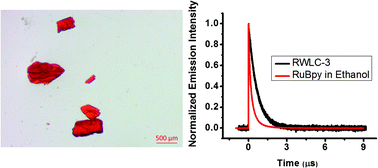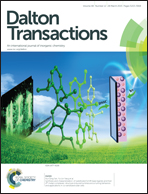A new photoactive Ru(ii)tris(2,2′-bipyridine) templated Zn(ii) benzene-1,4-dicarboxylate metal organic framework: structure and photophysical properties†
Abstract
It has now been demonstrated that Ru(II)tris(2,2′-bipyridine) (RuBpy) can be utilized to template the formation of new metal organic framework (MOF) materials containing crystallographically resolved RuBpy clusters with unique photophysical properties. Two such materials, RWLC-1 and RWLC-2, have now been reported from our laboratory and are composed of RuBpy encapsulated in MOFs composed of Zn(II) ions and 1,3,5-tris(4-carboxyphenyl)benzene ligands (C. L. Whittington, L. Wojtas and R. W. Larsen, Inorg. Chem., 2014, 53, 160–166). Here, a third RuBpy templated photoactive MOF is described (RWLC-3) that is derived from the reaction between Zn(II) ions and 1,4-dicarboxybenzene in the presence of RuBpy. Single Crystal X-ray diffraction studies determined the position of RuBpy cations within the crystal lattice. The RWLC-3 structure is described as a 2-fold interpenetrated pillared honeycomb network (bnb) containing crystallographically resolved RuBpy clusters. The two bnb networks are weakly interconnected. The encapsulated RuBpy exhibits two emission decay lifetimes (τ-fast = 120 ns, τ-slow = 453 ns) and a bathochromic shift in the steady state emission spectrum relative to RuBpy in ethanol.


 Please wait while we load your content...
Please wait while we load your content...